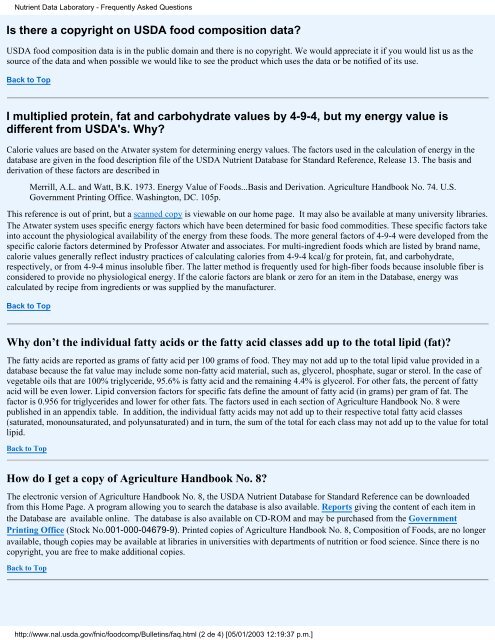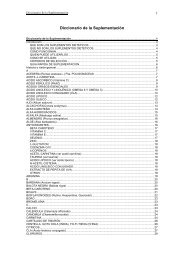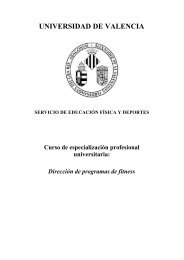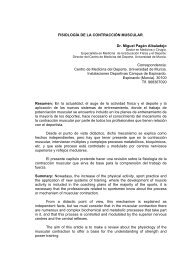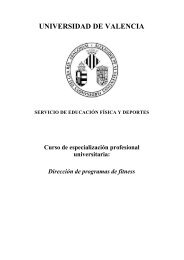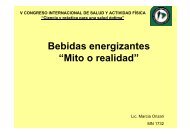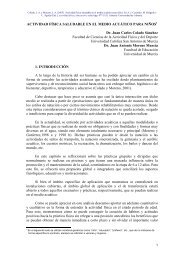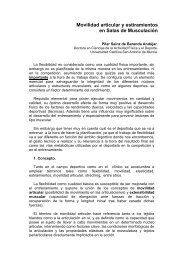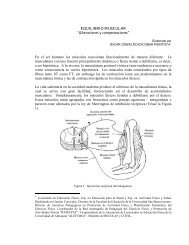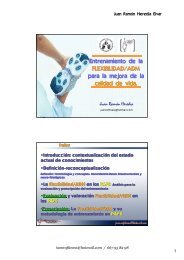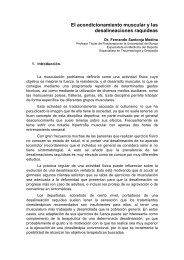Consumer.es ::: Salud y Alimentación - Felipe Isidro Donate
Consumer.es ::: Salud y Alimentación - Felipe Isidro Donate
Consumer.es ::: Salud y Alimentación - Felipe Isidro Donate
You also want an ePaper? Increase the reach of your titles
YUMPU automatically turns print PDFs into web optimized ePapers that Google loves.
Nutrient Data Laboratory - Frequently Asked Qu<strong>es</strong>tions<br />
Is there a copyright on USDA food composition data?<br />
USDA food composition data is in the public domain and there is no copyright. We would appreciate it if you would list us as the<br />
source of the data and when possible we would like to see the product which us<strong>es</strong> the data or be notified of its use.<br />
Back to Top<br />
I multiplied protein, fat and carbohydrate valu<strong>es</strong> by 4-9-4, but my energy value is<br />
different from USDA's. Why?<br />
Calorie valu<strong>es</strong> are based on the Atwater system for determining energy valu<strong>es</strong>. The factors used in the calculation of energy in the<br />
database are given in the food d<strong>es</strong>cription file of the USDA Nutrient Database for Standard Reference, Release 13. The basis and<br />
derivation of th<strong>es</strong>e factors are d<strong>es</strong>cribed in<br />
Merrill, A.L. and Watt, B.K. 1973. Energy Value of Foods...Basis and Derivation. Agriculture Handbook No. 74. U.S.<br />
Government Printing Office. Washington, DC. 105p.<br />
This reference is out of print, but a scanned copy is viewable on our home page. It may also be available at many university librari<strong>es</strong>.<br />
The Atwater system us<strong>es</strong> specific energy factors which have been determined for basic food commoditi<strong>es</strong>. Th<strong>es</strong>e specific factors take<br />
into account the physiological availability of the energy from th<strong>es</strong>e foods. The more general factors of 4-9-4 were developed from the<br />
specific calorie factors determined by Prof<strong>es</strong>sor Atwater and associat<strong>es</strong>. For multi-ingredient foods which are listed by brand name,<br />
calorie valu<strong>es</strong> generally reflect industry practic<strong>es</strong> of calculating calori<strong>es</strong> from 4-9-4 kcal/g for protein, fat, and carbohydrate,<br />
r<strong>es</strong>pectively, or from 4-9-4 minus insoluble fiber. The latter method is frequently used for high-fiber foods because insoluble fiber is<br />
considered to provide no physiological energy. If the calorie factors are blank or zero for an item in the Database, energy was<br />
calculated by recipe from ingredients or was supplied by the manufacturer.<br />
Back to Top<br />
Why don’t the individual fatty acids or the fatty acid class<strong>es</strong> add up to the total lipid (fat)?<br />
The fatty acids are reported as grams of fatty acid per 100 grams of food. They may not add up to the total lipid value provided in a<br />
database because the fat value may include some non-fatty acid material, such as, glycerol, phosphate, sugar or sterol. In the case of<br />
vegetable oils that are 100% triglyceride, 95.6% is fatty acid and the remaining 4.4% is glycerol. For other fats, the percent of fatty<br />
acid will be even lower. Lipid conversion factors for specific fats define the amount of fatty acid (in grams) per gram of fat. The<br />
factor is 0.956 for triglycerid<strong>es</strong> and lower for other fats. The factors used in each section of Agriculture Handbook No. 8 were<br />
published in an appendix table. In addition, the individual fatty acids may not add up to their r<strong>es</strong>pective total fatty acid class<strong>es</strong><br />
(saturated, monounsaturated, and polyunsaturated) and in turn, the sum of the total for each class may not add up to the value for total<br />
lipid.<br />
Back to Top<br />
How do I get a copy of Agriculture Handbook No. 8?<br />
The electronic version of Agriculture Handbook No. 8, the USDA Nutrient Database for Standard Reference can be downloaded<br />
from this Home Page. A program allowing you to search the database is also available. Reports giving the content of each item in<br />
the Database are available online. The database is also available on CD-ROM and may be purchased from the Government<br />
Printing Office (Stock No.001-000-04679-9). Printed copi<strong>es</strong> of Agriculture Handbook No. 8, Composition of Foods, are no longer<br />
available, though copi<strong>es</strong> may be available at librari<strong>es</strong> in universiti<strong>es</strong> with departments of nutrition or food science. Since there is no<br />
copyright, you are free to make additional copi<strong>es</strong>.<br />
Back to Top<br />
http://www.nal.usda.gov/fnic/foodcomp/Bulletins/faq.html (2 de 4) [05/01/2003 12:19:37 p.m.]


